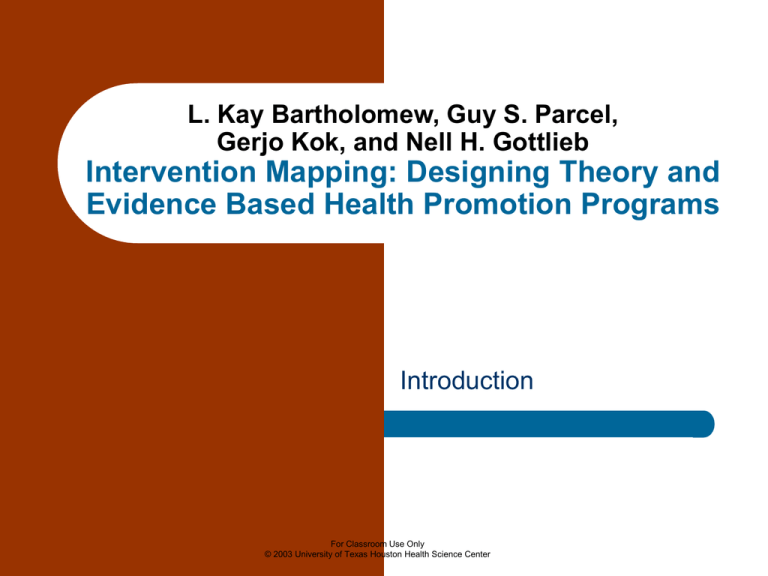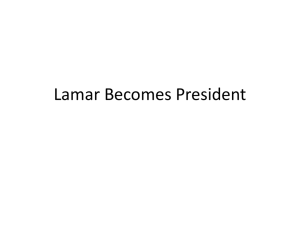Intervention Mapping Presentation
advertisement

L. Kay Bartholomew, Guy S. Parcel, Gerjo Kok, and Nell H. Gottlieb Intervention Mapping: Designing Theory and Evidence Based Health Promotion Programs Introduction For Classroom Use Only © 2003 University of Texas Houston Health Science Center Developing and Analyzing Health Promotion Programs What is Intervention Mapping? For Classroom Use Only © 2003 University of Texas Houston Health Science Center Intervention Mapping Development Questions that we couldn’t easily answer from available resources: THEORY When in the planning process do I use theory to guide my decisions? How do I know what theories and constructs to use? For Classroom Use Only © 2003 University of Texas Houston Health Science Center Intervention Mapping Development Questions that we couldn’t easily answer from available resources: EVIDENCE How do I make use of the experience of others and the results of program evaluations. How do I judge the the validity and strength of evidence? For Classroom Use Only © 2003 University of Texas Houston Health Science Center Intervention Mapping Development Questions that we couldn’t easily answer from available resources: EFFECTIVE METHODS How do I decide what intervention methods to use? How can I get from program goals and objectives to the specific intervention strategies for the program participants? How do I link program design with program implementation? For Classroom Use Only © 2003 University of Texas Houston Health Science Center Intervention Mapping Development Questions that we couldn’t easily answer from available resources: ECOLOGICAL APPROACH How do I address changing the behavior of people in the environment (i.e. make sure intervention addresses those people who are not at risk for the health problem , but are important to changing conditions that affect those at risk)? For Classroom Use Only © 2003 University of Texas Houston Health Science Center Possible innovation in the way we do planning : Explication of Multilevel Environmental Factors Related to Health and Behavior Explicit attempts to facilitate an ecological planning approach that takes into consideration both the social and physical environmental factors that influence a health problem For Classroom Use Only © 2003 University of Texas Houston Health Science Center Possible innovation in the way we do planning : Focus on Behavior of Both the At-Risk Population and the Agents of Environmental Change Explicit definition of behavior including performance objectives For Classroom Use Only © 2003 University of Texas Houston Health Science Center Possible innovation in the way we do planning – Proposed Determinants The explicit delineation of the factors that can be supported as [causally] related to behavioral or environmental causes of a health problem – The explicit intersection of these “determinants” with the performance necessary to carry out the health behavior or change the environmental factor MATRICES For Classroom Use Only © 2003 University of Texas Houston Health Science Center Possible innovation in the way we do planning : Matrices of Proximal Program Objectives The use of the Matrix device to plan methods and strategies for both The intervention itself Adoption, implementation, maintenance and wide diffusion of the intervention For Classroom Use Only © 2003 University of Texas Houston Health Science Center Possible innovation in the way we do planning: The Difference between Methods and Strategies The attempt to force a division between theoretical methods and practical strategies For Classroom Use Only © 2003 University of Texas Houston Health Science Center The goal of developing Intervention Mapping was to describe and clarify the processes that have been used to create effective interventions. Not to create a new process! For Classroom Use Only © 2003 University of Texas Houston Health Science Center Designing Theory- and Evidence-Based Health Promotion What is Intervention Mapping? For Classroom Use Only © 2003 University of Texas Houston Health Science Center Intervention Mapping For Classroom Use Only © 2003 University of Texas Houston Health Science Center Intervention Mapping Step I Matrices of Proximal Program Objectives State expected changes in behavior and environment Specify performance objectives Specify hypothetical determinants Create matrices (if necessary, differentiate the population) For Classroom Use Only © 2003 University of Texas Houston Health Science Center Creating a Matrix of Proximal Program Objectives Determinant 1 Determinant 2 Performance objective 1 Learning/change objective Learning/change objective Performance objective 2 Learning/change objective Learning/change objective For Classroom Use Only © 2003 University of Texas Houston Health Science Center Matrix on Determinants of Buying or Obtaining a Condom Performance Personal Determinants Objective Knowledge Self-efficacy Buys or obtains a condom Learning objectives Learning objectives Identify where Express confidence condoms can be in ability to go into a obtained store and buy a Identify location of condom condoms in stores Feel confident in Describe types of ability to deal with condoms and features embarrassment when for effectiveness buying a condom Explain how to buy or obtain a condom For Classroom Use Only © 2003 University of Texas Houston Health Science Center Intervention Mapping Step 2 Methods and Strategies Brainstorm methods Translate methods into practical strategies Organize methods and strategies by groups of leaning objectives at each level and check that methods are properly operationalized For Classroom Use Only © 2003 University of Texas Houston Health Science Center Methods and Strategies A Method is a general process for influencing changes in the determinants of behavior and environmental conditions A strategy is a practical technique for the application of methods in ways that fit with the intervention group and the context in which the intervention will be conducted For Classroom Use Only © 2003 University of Texas Houston Health Science Center Intervention Mapping Step 3 Producing Program Components Operationalize the strategies into plans that consider implementers and sites Develop design documents and produce materials Pretest programs and materials with intervention groups and implementers For Classroom Use Only © 2003 University of Texas Houston Health Science Center Intervention Mapping Step 4 Planning for Adoption, Implementation and Sustainability Develop a linkage system Create matrices of proximal program objectives Select methods and strategies and create a diffusion intervention table Write an adoption and implementation plan For Classroom Use Only © 2003 University of Texas Houston Health Science Center Intervention Mapping Step 5 Planning for Evaluation Develop an evaluation map State process and effect questions Develop or select indicators and measures using the matrices Specify evaluation designs and write the plan For Classroom Use Only © 2003 University of Texas Houston Health Science Center Analyzing Programs Behaviors – Environmental Conditions? What “determinants” are targeted? Justifiable “determinants”? Methods matched to “determinants” Methods operationalized into strategies? For Classroom Use Only © 2003 University of Texas Houston Health Science Center





